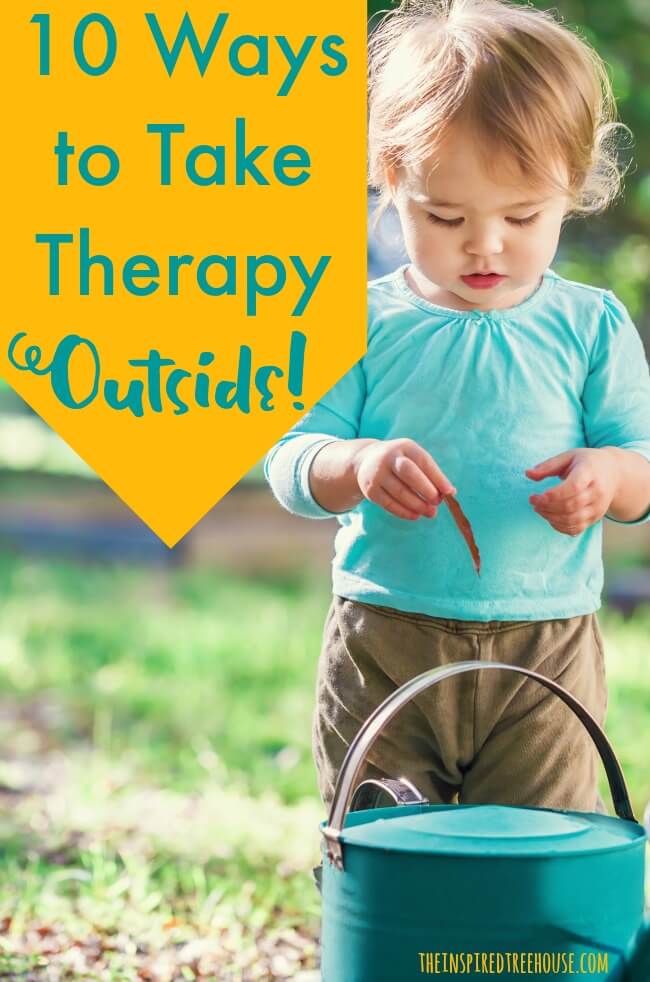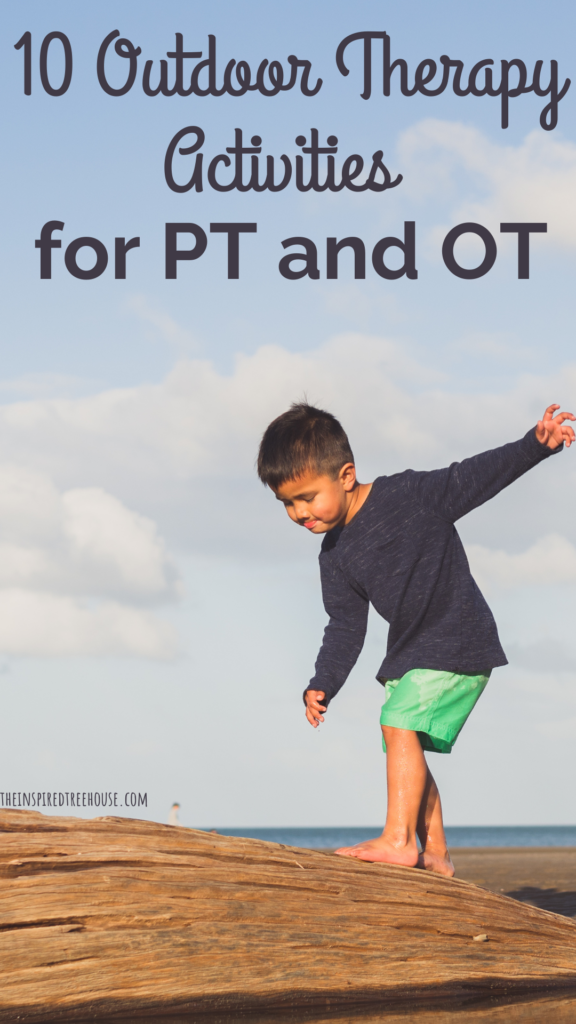These outdoor therapy activities are perfect for occupational and physical therapists who are ready to take their practice to the next level!
When we first read about Angela Hanscom and her amazing work, we couldn’t wait to get our hands on her book, Balanced and Barefoot. Angela is an inspiration who has revolutionized the world of pediatric occupational therapy by capitalizing on the therapeutic benefits of the outdoors.
Today, we’re sharing some of our favorite ways to take your therapy sessions outside and then we’ll delve into Angela’s work and hear more about her inspiring philosophy.
10 Outdoor Therapy Activities
1 || Get in the Garden
Get outside and plant something! Gardening is great for promoting fine motor skills (digging, manipulating seeds and plants, grasping garden tools) and sensory processing skills (get those hands dirty, smell the fresh herbs, cook something with your veggies and give it a taste!). Try these free printable seed collection pages to get you started
2 || Play on the Playground
Grab your copy of Balanced and Barefoot (see below for more info!), read up on what a high-quality outdoor play space should look like…and then find one near you!
There are millions of ways to facilitate therapy on the playground, hitting every skill from balance to strength to coordination and more! And stimulating the senses through movement is easy when you have access to swings, slides, seesaws and other equipment.
3 || Grab a Prop
When in doubt, grab a prop that will inspire movement, engagement, and creativity! Some of our favorites: hula hoops, balls, bubbles, and sidewalk chalk. Or, check out this collection of cool outdoor toys!
4 || Go on a Scavenger Hunt
You can easily create a scavenger hunt to elicit the skills you’re working on in therapy. Try our sensory motor scavenger hunt!
5 || Tag, You’re It!
Playing tag is the perfect way to get a therapy group warmed up and moving! We have tons of creative tag games to choose from that will target endurance, strength, coordination, and more!
6 || Get Wet!
Whether you take your therapy session to a stream, a beach, or even just a puddle in the parking lot – water can inspire all kinds of therapeutic play.
Throw on a pair of rain boots and go puddle jumping for some great proprioceptive input – or take a creek walk for some balance work. Head to the beach and build a sand castle or try digging with your feet! You can’t beat the calming sensory input of running water or waves!
7 || Go on a hike or nature walk
You can work pretty much every aspect of motor and sensory development on a simple hike in the woods.
8 || Take a ride
Get outside and work on learning how to ride a bike, balancing on rollerblades, or painting with whatever set of wheels you choose!
9 || Take Indoor Toys Outside!
It’s easy to breathe new life into toys and treatment materials simply by taking them outside. Toy cars, dinosaurs, and trains even Legos, blocks, and art/craft activities can all be done outside. We guarantee that you’ll see kids use materials in more unique and creative ways simply by taking them outside!
10 || Climb a tree!
Take those kiddos outside and hug a tree (then, climb it for great work on strength, grasping, endurance, coordination, and more!)
The most important thing about outdoor therapy sessions is to remember is to loosen up on the “therapy agenda” and allow kids to take the session in their own direction as much as possible. Very often, kids know exactly what they need and they know their limits too. You’ll be amazed at what they come up with on their own and you’ll be blown away by the therapeutic benefits of simple, unstructured play!
Outdoor Therapy: Timbernook & Angela Hanscom
Every so often, you stumble upon someone who reignites your passion and excitement about your job. Someone who doesn’t just talk the talk, but who gets out there and walks the walk, setting an example and inspiring others every single day.
If you haven’t met this someone yet, let me introduce you to our friend Angela Hanscom. You may recognize Angela’s name from a couple of her very popular Washington Post articles: Why so many kids can’t sit still in school today and The right – and surprisingly wrong – ways to get kids to sit still in class.
It was these articles that prompted us to learn more about Angela and her work as a pediatric occupational therapist in a very unconventional practice setting. You see, Angela’s clinic is in the woods. Not like a clinic inside a building on a wooded lot, but outside in the actual woods. Awesome, right?
Angela Hanscom is the founder of Timbernook, an outdoor day camp that integrates sensory experiences, imagination, and nature for all kids. The program is designed to foster creativity and independent play through exposure to the great outdoors. Angela isn’t just writing about how free, unstructured outdoor play impacts child development…she’s watching (and making) it happen each and every day.
We are honored that Angela, author of the new book, Balanced and Barefoot, took the time to answer a few questions for us about the importance of getting kids moving and playing outside and about her experience in a non-traditional practice setting as an OT.
Check out the Q & A below
Q&A With Angela Hanscom
1 – How did Timbernook and Balanced and Barefoot become your passion and life’s work? Why is the mission of expanding opportunities for unrestricted outdoor play for kids so near and dear to your heart?
TimberNook was really an experiment. I thought it was going to be just for a summer — a fun experience for my children and the children around us. Only, what I had created was something that was unique since my background was not traditional of a nature or forest program. I’m a pediatric occupational therapist. We aren’t typically found in the woods, but in clinics, schools, homes, or hospitals. That in itself was very different.
Unrestricted outdoor play, where children are free to move as nature intended, is essential for the growing child. Children need to be allowed to run through the woods, walk on moss-covered logs barefoot, swing high into the air, jump from rock to rock in a bubbling brook, and dig moats in the mud.
All of these things develop strong muscles and engage the senses — setting the child up for healthy sensory and motor development.
2 – Most pediatric therapists work in schools, clinics, or hospitals – all indoor settings. What advice would you give to a therapist who is interested in expanding his or her treatment sessions beyond the walls of a traditional practice setting?
The more I’ve observed children playing outdoors in natural settings, the more I’ve realized that nature is truly the “ultimate sensory experience.” We don’t need to spend $300 on a plastic “sensory” balance beam, when we can step outdoors and have children walk on a moss-covered log for free.
Getting children outdoors for therapy is really quite simple. It just takes a little thought and some creativity. You also need to view your outdoor environment as the “therapy clinic.” Here are a few ideas to get you started;
1 || Take your swings outdoors
2 || Have children play in mud puddles versus in sensory bins, where they can engage their whole bodies instead of just the hands
3 || Children can climb over fallen logs and trees
4 || Have them make clay faces on trees to challenge fine motor skills
5 || Cook over an open fire for those picky eaters.
Everything you do indoors, can be done outdoors and is most likely more meaningful and rewarding for the children.
3 – What practical tips would you give to parents, therapists, teachers, and caregivers to help them increase the amount of outdoor play their kids are getting?
There are so many ideas! I had fun writing this chapter in Balanced and Barefoot. One of my favorites is to invite other children over for the day – not just for a few hours.
Children tend to inspire each other to dive into creative play schemes. They all bring their own ideas to the play experience, making their time together a great back and forth of ideas that turn into their own little worlds. Children will often play more independently and for longer periods of time when there are other children to share their adventures with.
If you have a child struggling to play or find things to do outdoors, my first recommendation is to start inviting their friends over for the day….and send them outside. It takes practice, but over time they’ll become more and more competent with outdoor play.
Takeaways about outdoor therapy:
-The importance of allowing kids to take risks, solve problems, and explore independently. This one hit home more for me as a mom than as a therapist. Angela’s work has really inspired me to relax my “rules” and to find ways to open up more opportunities for my boys to explore independently outside.
-An analytical look at play spaces. We already know that the features of the environment can shape the way kids play. Angela’s chapter on playgrounds and indoor play spaces presents readers with another level of awareness about what quality play spaces for kids really look like.
-Inspiration to take my treatment sessions outside! We can all get in a rut sometimes – and I’ve definitely been in one lately. Taking therapy (or play, or classroom lessons) into the great outdoors is the perfect way to brighten things up and get creative!
-Outdoor therapy sessions can be for any age group! Sometimes we think it can be a bit easier to come up with outdoor play ideas for younger kids, but these teenage outdoor activities are a great place to start if you’re looking to take your sessions with tweens and teens outside!


Latest posts by Claire Heffron (see all)
- Cute Zipper Bags for Therapists - April 18, 2024
- Fairy Tale Games and Toys - April 12, 2024
- The Best Emotional Regulation Books for Kids - April 8, 2024

